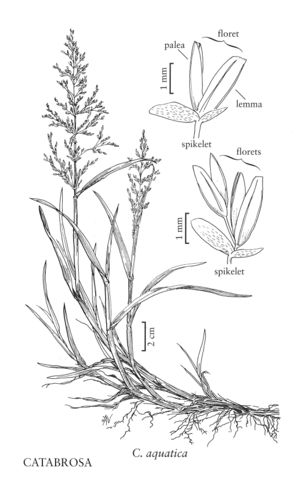Difference between revisions of "Catabrosa aquatica"
FNA>Volume Importer |
FNA>Volume Importer |
(No difference)
| |
Revision as of 19:17, 24 September 2019
Plants often stoloniferous. Culms 10-60 cm, glabrous. Sheaths glabrous; ligules 1-8 mm, acute to truncate, erose to subentire; blades (1)3-15(20) cm long, 2-13 mm wide. Panicles 3-35 cm long, (1)2-10(12) cm wide; nodes distant, with 3 to many, often very unequal branches. Spikelets 1.5-3.5(4) mm, terete to somewhat dorsiventrally compressed, lowest floret sessile, second floret on an elongate internode; rachilla internodes 0.75-1.5 mm. Lower glumes 0.7-1.3 mm, often not reaching the base of the distal floret; upper glumes 1.2-2.2 mm; lemmas 2-3 mm; anthers 2-3 mm. 2n = 20, 30.
Distribution
Ariz., Colo., N.Mex., Wash., Wyo., Utah, Alaska, Wis., Iowa, N.Dak., Nebr., Oreg., S.Dak., Mont., Nev., Alta., B.C., Greenland, Man., N.B., Nfld. And Labr., Ont., P.E.I., Que., Sask., Idaho
Discussion
Catabrosa aquatica grows in wet meadows and the margins of streams, ponds, and lakes in the Flora region, Argentina, Chile, Europe, and Asia. It is listed as endangered in Wisconsin. Although palatable, it is never sufficiently abundant to be important as a forage species. The species is regarded here as being variable, but having no infraspecific taxa.
Selected References
None.
